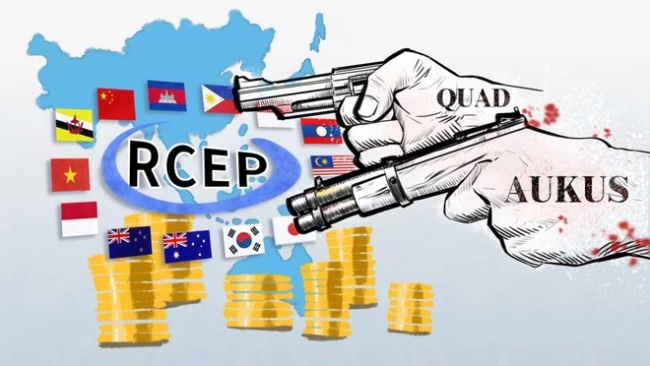Will fabricating external threats save America?

Introducing its so-called Asia-Pacific Rebalance in 2009, the U.S. pivoted back towards a Cold War mentality that aims to strategically encircle the great powers on the other side of the Pacific. In 2017, the Trump administration called China and Russia "revisionists" in the updated U.S. National Security Strategy. In 2019, the administration released its Indo-Pacific Strategy Report, with China's maritime presence a core target.
Since Joe Biden replaced Donald Trump, American warships have repeatedly passed through the Taiwan Straits and the South China Sea, conducting joint military exercises around China. Warmongering instruments such as the Quad mechanism and the U.S.-UK-Australia (AUKUS) alliance have emerged one after another, apparently targeting China militarily.
How could China – a country that has risen peacefully, actively opens up to the world and continuously makes great contributions to humanity – have become a thorn in the flesh for the U.S.?
The answer lies with the U.S. itself, not with China.
The U.S. has always professed itself to be a beacon of democracy. It projects itself as a liberal power where the young are bursting with vitality, the middle-aged have strong aspirations, and the elderly are peaceful and happy. In recent years, however, underneath the fancy veneer of a superpower, social divisions, political polarization, racial conflicts, unemployment and other problems have been growing. At the same time, pathways for the people at the bottom of society to move up the social ladder are closing, and Americans are losing hope of a better future.
A horrendous city
As the place where the Declaration of Independence was signed, Philadelphia, the birthplace of the American Constitution and the U.S. capital city between 1790 and 1800, is a revered city in the nation's history. It was once the biggest metropolitan economy in the state of Pennsylvania. It became America's first World Heritage city in 2015 and is seen by Americans as a perfect mix of history and modernity.
But today, the once bustling Kensington Avenue in the city, linked forever to the independence pronouncement, has made dubious history by being fingered as the neighborhood hit hardest by the worst urban opioid crisis in the country. It has decayed into the largest open-air drug market along the American East Coast and a gathering place for homeless young addicts. Young people desperate for drugs shiver among garbage dumps; those having their cravings temporarily quenched deliriously slouch around like walking dead; thirsty guys eagerly inject drugs into their bodies with a ghostly look. These are common scenes on today's Kensington Avenue.
Drug dealers across the country purchase their products from Philadelphia and resell them in their home states at a much higher price. A large number of young boys and girls, clueless about how to get their lives right, are lost in the turbulence.

The residents, mostly people of color, have been practically left to deal with the drug problem in their community. Eduardo Esquivel, the president of the Kensington Neighborhood Association, calls it a policy of containment that ensures the problem does not spill over to white areas whose residents have historically driven in to buy drugs, use them, and leave.
"Let's be clear: The highly successful containment effort in Kensington is systemic racism in action," he wrote in August.
The angry Rust Belt
A mere 40 years ago, the area around the Great Lakes and the Midwest was dominated by top-notch industrial hubs. The Rust Belt, as it has become known, was not "rusty" back then but an engine for America's economic development.
However, the rising costs of labor, the capital-intensive nature of manufacturing, competition from overseas and new technologies resulted in the displacement of workers. The engine thus went rusty, and unemployment soared.